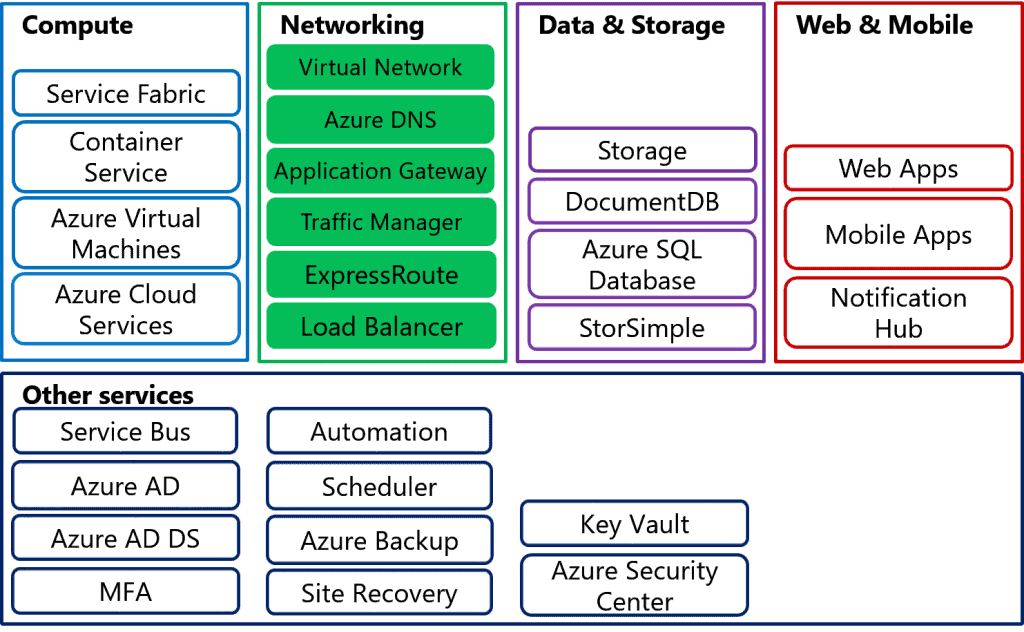A major incentive for adopting cloud solutions such as Azure is to enable information technology (IT) departments to move server resources to the cloud. This can save organizations money, and simplify operations by removing the need to maintain expensive datacenters with uninterruptible power supplies, generators, multiple fail-safes, clustered database servers, and so on. This is particularly advantageous for small and medium-sized companies, which might not have the expertise to maintain their own robust infrastructure.
Once the resources are moved to Azure, they require the same networking functionality as an on-premises deployment, and in specific scenarios require some level of network isolation. Azure networking components offer a range of functionalities and services that can help organizations design and build cloud infrastructure services that meet their requirements.
Azure Networking Components
Key terminology for Azure Networking is listed below. Each of these areas will be discussed in more detail throughout this course:
Virtual networks
Azure Virtual Network is a fundamental component that acts as an organization’s network in Azure. Organizations can use virtual networks to connect resources. Virtual networks in Microsoft Azure are network overlays that you can use to configure and control connectivity between Azure resources such as VMs and load balancers.
IP addresses
VMs, Azure load balancers, and application gateways in a single virtual network require unique IP addresses in the same way as clients in an on-premises subnet do. This enables these resources to communicate with each other. There are two types of IP addresses that are used in a virtual network:
Private IP addresses. A private IP address is allocated to a VM dynamically or statically from the defined scope of IP addresses in the virtual network. This address is used by VMs in the virtual network to communicate with other VMs in the same virtual network connected VNets/networks through a gateway/ExpressRoute connection.
Public IP addresses. Public IP addresses allow Azure resources to communicate with external clients, and are assigned directly at the virtual network interface card of the VM or to the load balancer.
Subnets
You can further divide your network by using subnets for logical and security isolation of Azure resources. Each subnet contains a range of IP addresses that fall within the virtual network address space.
Network interface card
VMs communicate with other VMs and other resources on the network by using virtual network interface cards (NICs). Virtual NICs configure VMs with private and optional public IP address. VMs can have more than one NIC for different network configurations.
DNS
The Domain Name System (DNS) enables clients to resolve user-friendly fully qualified domain names (FQDNs), such as www.adatum.com, to IP addresses. Azure provides a DNS system to support many name resolution scenarios. However, in some cases, such as hybrid connection you might need to configure an external DNS system to provide name resolution for virtual machines on a virtual network.
Azure load balancer and internal load balancer
To increase availability and scalability, you can create two or more VMs that publish the same application. For example, if three VMs host the same website, you might want to distribute incoming traffic between them and ensure that if one VM fails, traffic is distributed automatically to the other two. You can use an Azure load balancer to enable this traffic distribution between VMs. In this configuration, a single endpoint is shared between multiple VMs. The Azure load balancer automatically distributes requests across those VMs as the requests arrive at the endpoint. You can use two types of Azure load balancers:
Internal load balancer. The internal load balancer enables you to load balance traffic between VMs in the same cloud service (for classic model), or between VMs and a virtual network with a regional scope, where the input IP address of the load balancer is a private IP address.
Internet-facing load balancer. The internet-facing load balancer enables you to load balance incoming Internet traffic to VMs.
Application gateway
Application gateways provide load-balanced solutions for network traffic that is based on the HTTP protocol. They use routing rules as application-level policies that can offload Secure Sockets Layer (SSL) processing from load-balanced VMs. In addition, you can use application gateways for a cookie-based session affinity scenario.
Traffic Manager
Microsoft Azure Traffic Manager is another load-balancing solution that is included within Azure. You can use Traffic Manager to load balance between endpoints that are located in different Azure regions, at hosted providers, or in on-premises datacenters. These endpoints can include Azure VMs and Azure websites. You can configure this load-balancing service to support priority or to ensure that users connect to an endpoint that is close to their physical location for faster response.
Network security groups
You can use network security groups to provide network isolation for Azure resources by defining rules that can allow or deny specific traffic to individual VMs or subnets. This enables you to design your Azure virtual network to provide a network experience that is similar to an on-premises network. You can achieve the same functionality in your Azure virtual network as you would in the on-premises networks, such as perimeter networks (also known as DMZ or demilitarized zone).
User Defined Routes
User Defined Routes (UDR) control network traffic by defining routes that specify the next hop of the traffic flow. You can assign User Defined Routes to virtual network subnets.
Forced tunneling
With forced tunneling you can redirect internet bound traffic back to the company’s on-premises infrastructure. Forced tunneling is commonly used in scenario where organizations want to implement packet inspection or corporate audit.
Regional virtual networks
Azure Virtual Network is bound to Azure subscriptions and it is not possible for multiple subscriptions to use the same Azure virtual network. If you need to provide communications between different Azure subscriptions, you need to create separate Azure virtual networks in each subscription and then use site-to-site virtual network connections or the Microsoft Azure service ExpressRoute, to connect them. All new virtual networks are regional virtual networks. This means that they can span a complete Azure region or datacenter. This differs from the legacy implementation of virtual networks in Azure, which were restricted to a single affinity group, allowing you to co-locate virtual networks, storage accounts, and services in the physical proximity to each other within the same area of a single datacenter. If you have older virtual networks in your subscription, these could be tied to an affinity group. However, over time, you need to migrate all virtual networks to regional virtual networks and remove their ties to specific affinity groups.
Cross-premises network connectivity
Virtual networks in Microsoft Azure also enable you to extend your on-premises networks to the cloud. To extend your on-premises network, you can create a virtual private network (VPN) between your on-premises computers or networks and an Azure virtual network. Alternatively, you can use ExpressRoute to provide a connection to an Azure virtual network that does not cross the Internet. Using these two methods, you can enable on-premises users to access Azure services as if they were physically located on-premises in your own datacenter.
To connect to an Azure virtual network from an on-premises network, you can use:
- A point-to-site VPN
- A site-to-site VPN
- ExpressRoute
- VNet-to-VNet VPN



